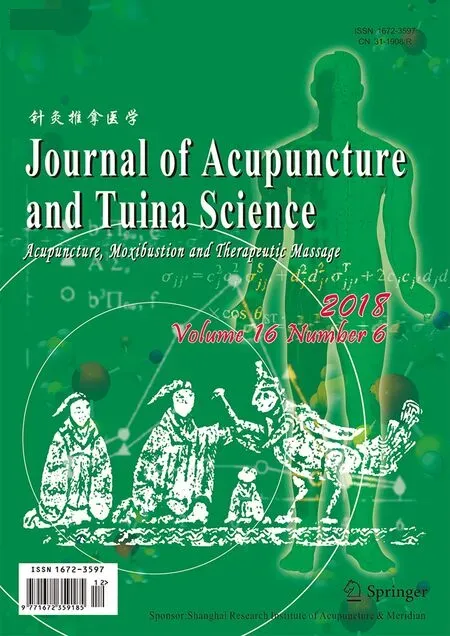Effect of tuina exercise on simple obesity in college students
2019-01-14Hongxiao吕红肖WuZhongqiu吴中秋ZhangShaofeng张韶峰XuLei许雷ZhangKai张凯LiangYulei梁玉磊ZhangRuijuan张瑞娟ChenZilong陈子龙LiJie李洁
Lü Hong-xiao (吕红肖), Wu Zhong-qiu (吴中秋), Zhang Shao-feng (张韶峰), Xu Lei (许雷), Zhang Kai (张凯),Liang Yu-lei (梁玉磊), Zhang Rui-juan (张瑞娟), Chen Zi-long (陈子龙), Li Jie (李洁)
1 Hebei University of Chinese Medicine, Shijiazhuang 050200, China
2 Shijiazhuang Medical College, Shijiazhuang 050599, China
Abstract Objective: To observe the effect of tuina exercise on simple obesity in college students.
Keywords: Tuina; Physical and Breathing Exercises; Shaolin Neigong; Yi Jin Jing; Auricular Acupoint Sticking; Obesity;Body Mass Index; Lipids
Simple obesity is a condition in which energy intake is more than consumed and stored in the body in the form of fat, with obesity as the main clinical symptom,or coupled with metabolic disorders[1]. With the changes in people's lifestyles, eating habits and other factors, the growth rate of obesity in China has been increasing year by year. Obesity not only affects the patient's physical appearance, but also is a dangerous cause of hypertension, coronary heart disease, diabetes,fatty liver, atherosclerosis and other diseases that seriously endanger human health[2]. We treated 28 college students with simple obesity by tuina exercise,comparing with 29 cases treated by auricular acupoint sticking. The report is given as follows.
1 Clinical Data
1.1 Diagnostic criteria
This was based on the diagnostic criteria for simple obesity developed by the 5th National Conference on Obesity Research[3]. The body mass index (BMI) was used as a diagnostic criteria for simple obesity.
BMI = Weight (kg) ÷ [Height (m)]2. BMI ≥25 kg/m2,≤26 kg/m2for overweight; BMI >26 kg/m2, ≤30 kg/m2for mild obesity; BMI >30 kg/m2, ≤40 kg/m2for moderate obesity; BMI >40 kg/m2for severe obesity.
BMI ≥26 kg/m2; aged 18-26 years old (including 18 and 26 years old); didn't receive weight loss therapy over the recent 3 months; voluntary participation and informed consent.
1.2 Inclusion criteria
1.3 Exclusion criteria
Failed to meet the above inclusion criteria; obesity caused by factors such as diabetes, thyroid dysfunction,essential hypertension and/or drugs; accompanied by diseases that need to strictly forbid exercises, or can't take tuina exercise.
1.4 Rejection criteria
Poor compliance; failed to follow the tuina exercise training; midway exit or accidents; added treatments and resulted in incorrect analysis of the treatment;failed to stick to the treatment; withdrew by one's own will, or withdrew the informed consent form.
1.5 Statistical methods
All data were processed by SPSS version 13.0 software. Measurement data in normal distribution were described as mean ± standard deviation (±s),and analyzed by t-test; data not in normal distribution were analyzed by rank-sum test. The Chi-square test was used to compare the ratio and composition ratio.The rank data were tested by rank-sum test. A P value less than 0.05 indicated statistical significance.
1.6 General data
A total of 57 patients with simple obesity were included in the study. The cases were collected in Shijiazhuang Medical College between March and May,2017. According to the stratified random method, the patients were allocated into an auricular acupoint sticking group of 28 cases and a tuina exercise group of 29 cases. There were no significant differences in gender, age, obesity, and BMI between the two groups(all P>0.05), indicating that the two groups were comparable (Table 1).

Table 1. Comparison of general data between the two groups of patients
2 Treatment Methods
2.1 Tuina exercise group
The tuina exercise group was treated with tuina exercise mainly based on exercises of Shaolin Neigong and Yi Jin Jing (Sinew-transforming Qigong Exercises).The training was led by a teacher specialized in Yi Jin Jing (Sinew-transforming Qigong Exercises) with 90 min each time, the first 10 min of which was for warming-up,and then followed by 40-minute exercise of Shaolin Neigong and 30-minute exercise of Yi Jin Jing(Sinew-transforming Qigong Exercises), and the last 10 min was for ending exercises. The training was given once every other day, and 10 times constituted a course,for two courses in total. All movements were based on Exercise and Techniques of Tuina[4].
2.1.1 Shaolin Neigong exercises
Positions of the lower limbs included the standing squat with feet paralleled, the standing squat with feet closed, the big squat, the arch squat, and the horseriding squat (Figure 1-Figure 5).
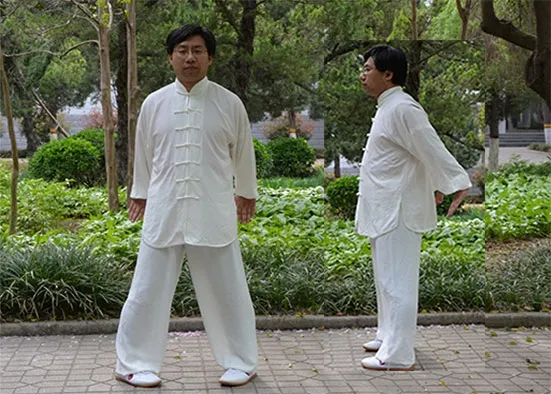
Figure 1. Standing squat with feet paralleled

Figure 2. Standing squat with feet closed
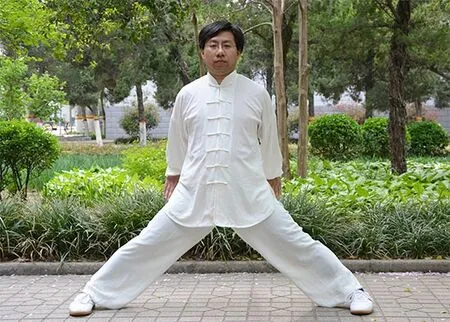
Figure 3. Big squat
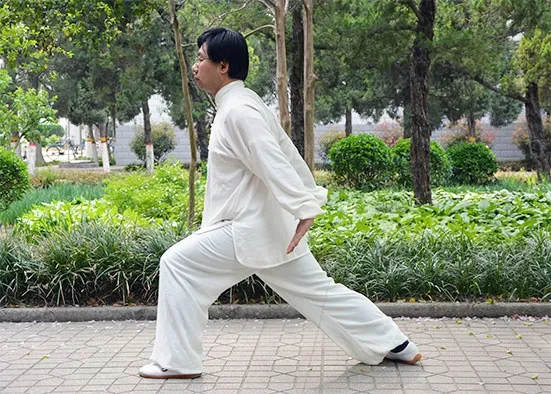
Figure 4. Arch squat
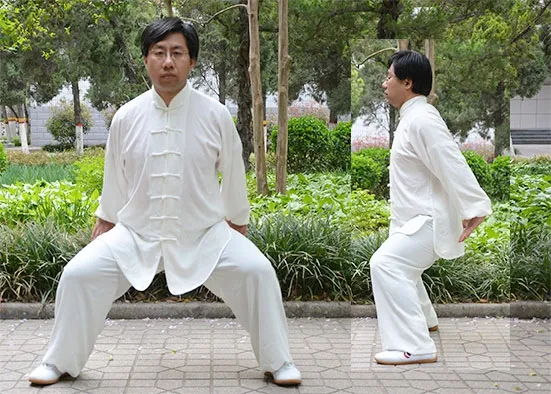
Figure 5. Horse-riding squat
Movements of upper limbs included pushing eight horses forward, dragging nine oxen by their tails,flatting the hands to hold the tower, extending wings of phoenix, swinging lotus leaves by the wind, the overlord lifting the ancient cooking vessel, touching the sky and the earth, refloating the moon from the bottom of the sea, and drilling hole on the earth by black dragon(Figure 6-Figure 14).
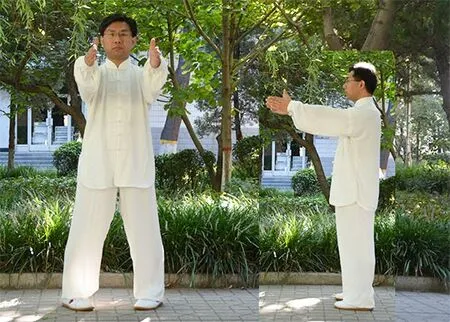
Figure 6. Pushing eight horses forward

Figure 7. Dragging nine oxen by their tails

Figure 8. Flatting the hands to hold the tower
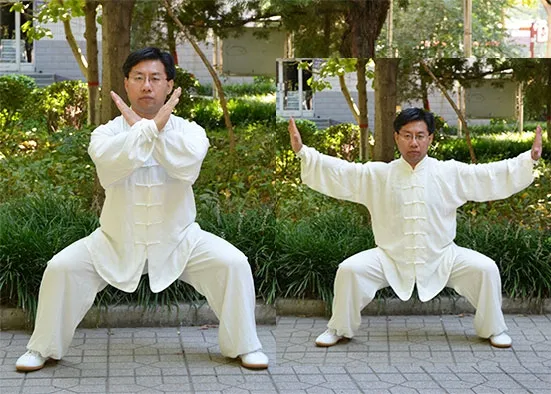
Figure 9. Extending wings of phoenix

Figure 10. Swinging lotus leaves by the wind

Fiugre 11. Overlord lifting the ancient cooking vessel

Figure 12. Touching the sky and the earth

Figure 13. Refloating the moon from the bottom of the sea
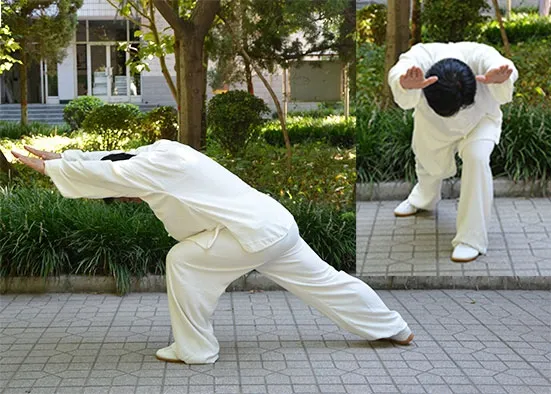
Figure 14. Drilling hole on the earth by black dragon
2.1.2 Yi Jin Jing (Sinew-transforming Qigong Exercises)exercises
Four basic movements of Wei Tuo presenting the pestle, shouldering demon-conquered cudgel horizontally, lifting the hands to touch the sky entrance,and grabbing and resetting a star (Figure 15-Figure 18).
2.2 Auricular acupoint sticking group
The auricular acupoint sticking group was treated by applying Wang Bu Liu Xing (Semen Vaccariae) to auricular acupoints[5].
Acupoints: Sympathetic (AH6m), Large Intestine (CO7),Stomach (CO4), Spleen (CO13), Hunger (TG2), Triple Energizer (CO17) and Endocrine (CO18).

Figure 15. Wei Tuo presenting the pestle

Figure 16. Shouldering demon-conquered cudgel horizontally

Figure 17. Lifting the hands to touch the sky entrance

Figure 18. Grabbing and resetting a star
Method: After routine disinfection, the doctor used a pair of pincers with the left hand holding a desensitizing tape with Wang Bu Liu Xing (Semen Vaccariae) and applied it to auricular acupoints with the right hand.Then the doctor pressed the tape until the patient felt a sensation of sourness, distending, numbness and heat.The patients were told to press the acupoints by themselves for 3-5 min before meals when they were hungry to an extent as mentioned above. Each time the auricular application was kept for 4 d. Two sides of the auricular acupoints were alternately used, 5 times made one course and 2 courses were performed.
2.3 Notes
During treatment, the patients were required to control their diet. A reasonable combination of foods was suggested for three meals. Foods of high fat and calory were not recommended. Early and eccentric dinner was suggested.
3 Therapeutic Effect Observation
3.1 Outcome measures
Weight, BMI, waist circumference, hip circumference,serum total cholesterol (TC), triglyceride (TG), highdensity lipoprotein cholesterol (HDL-C) and low-density lipoprotein cholesterol (LDL-C) were measured before and after treatment.
3.1.1 Height, weight, waist and hip circumferences
The outerwear and shoes were removed before the same meter was used to measure the height, weight,and waist and hip circumferences on an empty stomach before and after treatment. The BMI was calculated afterwards. When measuring the waist and hip circumferences, the patient was required to separate the feet by 25-30 cm. The tape for measuring should be close to the patient's skin. The waist circumference should be measured at the midpoint of the horizontal anterior superior iliac spine and the lower edge of the 12th rib. The hip circumference was measured at the prominent of the patient's pubic symphysis and the posterior gluteus maximus.
3.1.2 Blood indicators
Five milliliter of venous blood was drawn on an empty stomach in the morning before and after treatment. The blood sample was kept in 37 ℃ water bath for 30 min and then centrifuged at 3 000 r/min for 10 min, after which the supernatant was extracted.Enzyme assay for TC (AUZ3625 TC kit), GPO-POD assay for TG (AUZ3592 TG kit), direct assay for HDL-C(AUZ3661 HDL-C kit) and LDL-C (AUZ3659 LDL-C kit)were used.
The above kits were all produced by Beckman Coulter Laboratory Systems (Suzhou) Co., Ltd.
3.2 Efficacy criteria
This was based on the efficacy criteria developed by the 5th National Conference on Obesity Research[3].
Markedly effective: Most of the clinical symptoms disappeared, BMI decreased by ≥4 kg/m2, or weight loss was ≥5 kg.
Effective: Significantly reduced clinical symptoms,BMI decreased by ≥2 kg/m2, and <4 kg/m2, or weight loss was ≥2 kg, but <5 kg.
Invalid: No significant improvement in clinical symptoms, BMI decreased by <2 kg/m2, or weight loss was <2 kg.
3.3 Results
3.3.1 Comparison of clinical effects
After treatment, the total effective rate was 85.7% in the tuina exercise group and 86.2% in the auricular acupoint sticking group. There was no significant difference between the two groups (P>0.05), (Table 2).3.3.2 Comparison of physical indicators
There were no significant differences in weight, BMI,waist and hip circumferences between the two groups before treatment (all P>0.05), indicating the comparability. After treatment, the above items were significantly lower than those before treatment in the two groups (all P<0.05). The changes of the waist and hip circumferences after treatment in the tuina exercise group were better than those in the auricular acupoint sticking group (both P<0.05), showing better improvements of waist and hip circumferences in the tuina exercise group than the auricular acupoint sticking group. See Table 3 for details.
3.3.3 Comparison of blood indicators
There were no significant differences in TC, TG, HDL-C and LDL-C before treatment between the two groups(all P>0.05), indicating that the two groups were comparable. After treatment, there were no significant changes in blood indicators in the two groups (all P>0.05). See Table 4 for details.

Table 2. Comparison of clinical effects between the two groups
Table 3. Comparisons of the physical indicators between the two groups before and after treatment (±s)

Table 3. Comparisons of the physical indicators between the two groups before and after treatment (±s)
Note: Compared with the same group before treatment, 1) P<0.05; compared with the auricular acupoint sticking group after treatment,2) P<0.05
Group n Time Weight (kg) BMI (kg/m2)Waist circumference (cm) Hip circumference (cm)Before treatment 77.52±11.09 28.69±2.97 91.66±8.09 106.41±6.39 Auricular acupoint sticking 29After treatment 73.30±10.991) 27.19±3.041) 87.52±7.951) 103.90±6.671)Difference value 4.22±1.95 1.56±0.69 4.14±2.29 2.52±1.89 Before treatment 77.05±12.98 28.83±3.46 92.61±9.00 106.25±6.54 Tuina exercise 28After treatment 71.94±12.221) 26.90±3.101) 83.68±8.621) 100.04±6.021)Difference value 5.11±2.58 1.93±0.99 8.39±2.842) 6.21±2.732)
Table 4. Comparison of blood parameters before and after treatment between the two groups (±s)

Table 4. Comparison of blood parameters before and after treatment between the two groups (±s)
Group n Time TC TG HDL-C LDL-C Before treatment 4.40±0.57 1.25±0.49 1.52±0.22 2.57±0.27 Auricular acupoint sticking 29After treatment 4.46±0.68 1.15±0.39 1.56±0.22 2.51±0.37 Difference value -0.06±1.43 0.10±0.43 -0.04±0.25 0.06±0.37 Before treatment 4.36±0.70 1.40±0.57 1.59±0.18 2.49±0.37 Tuina exercise 28After treatment 4.39±0.85 1.37±0.69 1.50±0.20 2.48±0.52 Difference value -0.03±0.58 0.03±0.62 0.09±0.25 0.02±0.45
4 Discussion
Chinese medicine believes that obesity is associated with obstruction of meridians and dysfunctions of the Zang-fu organs, particularly the spleen, stomach and kidney[6-7]. The spleen and stomach are known as the pivot of qi movement. Normal functioning of the spleen and stomach in transportation and transformation guarantees normal distribution of nutrients transformed from water and food and absence of phlegm dampness, which in turn maintains free flow of qi. As a result, spleen deficiency is considered a major cause of simple obesity by many researchers[8-9].
This study adopted Shaolin Neigong and Yi Jin Jing(Sinew-transforming Qigong Exercises) to treat simple obesity through regulating the functions of the zang-fu organs and unblocking meridians[10]. Internally, the Shaolin Neigong highlights essence, qi and spirit.Externally, it focuses on the sinews, bones and muscles by guiding qi with intent, generating force with qi and sending the qi and force to the four extremities via the pathways of meridians. The standing posture is the very basic standing exercise. The four extremities are the real source of qi of the twelve meridians. This posture helps to unblock qi and blood of the twelve meridians to nourish limbs, bones, Zang-fu organs and thus harmonize yin and yang of the Zang-fu organs. Yi Jin Jing(Sinew-transforming Qigong Exercises) benefits both the body and mind. It strengthens the spleen by harmonizing the heart and unblocks collaterals by stretching sinews. Harmonizing the mind helps to regulate the consciousness, thinking and mental activities to make people relax and delighted. According to the five-element theory, fire produces earth. Normal functioning of the heart helps to strengthen the functions of the spleen. Normal functioning of the spleen and stomach maintains normal distribution of nutrients. In addition, the liver maintains free flow of qi.Normal functioning of the liver guarantees the normal functioning of the spleen. In the meantime, the rotation,flexion and stretching in soft, flexible Yi Jin Jing(Sinew-transforming Qigong Exercises) help to stimulate points on the back[11], including Jiaji (EX-B 2) points to unblock the Governor Vessel and Conception Vessel and regulate the qi activities of the Zang-fu organs[12-14].Combination of the two exercise methods can restore normal functions of the spleen in transportation and transformation and is therefore effective for simple obesity.
Studies have shown that obesity patients are mostly accompanied by dyslipidemia, usually characterized by high cholesterol and hypertriglyceridemia[15], while TG is the most abundant lipid in the human body and can produce energy by decomposition; when there are too many free fatty acids, it can also be stored in tissues such as liver in the form of triacylglycerol[16]. TC is the sum of cholesterol contained in all lipoproteins in blood,including free cholesterol and cholesterol lipid[17]. LDL-C plays a very important role in the metabolism of cholesterol and is the main carrier of cholesterol in plasma[18]. Patients with simple obesity have an increased effect on the energy intake of their own adipose tissue, which leads to an increase in the synthesis and storage of TG. When the content of HDL-C decreases, the ability to clear TC would be weakened,resulting in the high content of TC in blood, which leads to inhibition of the ability of the liver to synthesize LDL-C receptor, thereby increasing the LDL-C content,and forming a vicious circle. In the end, the obesity aggravates[19].
The results of this study showed that the training of tuina exercises had little effect on the blood lipids of college students with simple obesity, which might be related to the age of the sample population. The subjects in this study were all young people in their 20's,with strong metabolism and self-repair ability, and the initial blood lipid levels of the subjects were basically within the normal range. Blood lipids have certain positive effects on the growth and development of the human body. For example, cholesterol is indispensable substance in human life activities, important component of the cell membrane and raw material for the synthesis of adrenocortical hormones and sex hormones in the body. It is crucial to the growth and development of the body. The metabolism of sugar, fat and protein rely on the stable function of cholesterol.Tuina exercises can reduce the patient's weight, BMI,waist and hip circumferences while maintaining blood lipids within the normal range, indicating that this is a healthy and effective way to lose weight.
In this study, the auricular application of Wang Bu Liu Xing (Semen Vaccariae) was to stimulate the specific acupoints of the ear, taking the function of keeping healthy transportation of spleen and stomach qi and warming kidney yang to achieve the purpose of weight loss by clearing phlegm to drain dampness and warming yang to dispel water[20-21]. Modern research believes that stimulating auricular acupoints can produce nerve impulses to the hypothalamus to inhibit the feeding center and reduce the sensation of hunger to help achieve the goal of weight loss. Auricular acupoint sticking requires professional operation. Certain cases may have redness and swelling of the ear skin after acupressure. The qigong exercises were used to balance yin and yang, regulate the viscera and transport the spleen and stomach qi through the self-practice of the patients, so as to achieve the goal of eliminating fat and losing weight. Compared with auricular acupoint sticking, qigong exercise had better effect in improving the waist and hip circumferences.
In summary, both tuina exercises and auricular acupoint sticking could be used for the treatment of simple obesity. The therapeutic efficacy of qigong exercise is better than that of auricular acupoint sticking in improving the waist and hip circumferences. Besides,the exercise could help lose weight while regulating the physical and mental health to achieve the coordination of the mind and body. Therefore, tuina exercise is green and effective therapeutic method to lose weight, and deserves further research and promotion.
Conflict of Interest
There was no potential conflict of interest in this article.
Acknowledgments
This work was supported by Science and Technology Plan Project of Hebei Provincial Department of Science and Technology (河北省科技厅科技计划项目, No.16277704D).
Statement of Informed Consent
Informed consent was obtained from all individual participants included in this study.
Received: 8 May 2018/Accepted: 12 June 2018
猜你喜欢
杂志排行
Journal of Acupuncture and Tuina Science的其它文章
- Analysis of acupoint-selection patterns in acupuncture-moxibustion treatment of polycystic ovarian syndrome based on data mining
- Clinical observation of needling gluteus medius muscle trigger point plus chiropractic for sacroiliac joint subluxation
- Clinical observation on tuina plus foot bath with Chinese medicine for diabetic foot in early stage
- Therapeutic effect observation on acupuncture plus umbilicus application with Chinese medicine in treating detrusor underactivity
- Memory response to manual acupuncture in chronic insomniacs: evidence from event-related potentials
- Fire-needle therapy for deglutition disorders in post-stroke pseudobulbar palsy:a randomized controlled trial
